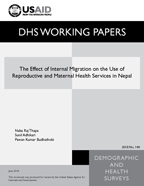
Abstract:
The purpose of this study is to examine the
effect of internal migration on the use of
reproductive and maternal health services in
Nepal, using data from the 2016 Nepal
Demographic and Health Survey. The study
population is married women age 15-49. The
study used descriptive and logistic
regression analysis, with three outcome
measures: current use of modern
contraception, at least four antenatal care
visits, and place of delivery.
Overall, 44% of eligible women reported
current use of modern contraception, 71% of
women made at least four antenatal visits,
and 58% of women delivered their most recent
birth in the past 5 years in a health
facility. Our findings show that, after
adjusting for background characteristics,
women who are recent migrants to the current
district (arrived 0-4 years ago) have lower
odds of using modern contraceptives, higher
odds of attending at least four antenatal
visits, and higher odds of delivering in a
health facility. By migration streams, modern
contraceptive use is significantly higher
among urban-to-urban migrants and urban non-
migrant women. Urban-to-urban migrant women
and rural-to-urban migrant women have
significantly higher odds of attending at
least four antenatal visits for the most
recent birth compared with rural-to-rural
migrant women. Women who moved between urban
areas, women who moved from an urban to a
rural area, women who moved from a rural area
to an urban area, and urban non-migrants are
significantly more likely to deliver in a
health facility compared with women who moved
between rural areas.
Several socioeconomic and demographic factors
are also significant in their association
with contraceptive use, antenatal visits, and
place of delivery. These differences by
internal migration status should be
considered in reproductive and maternal
health services interventions.
KEY WORDS: Migration, migration streams,
migrant, non-migrant, contraceptive use,
antenatal care, duration of stay, place of
delivery
 The Effect of Internal Migration on the Use of Reproductive and Maternal Health Services in Nepal (PDF, 1053K)
The Effect of Internal Migration on the Use of Reproductive and Maternal Health Services in Nepal (PDF, 1053K)
